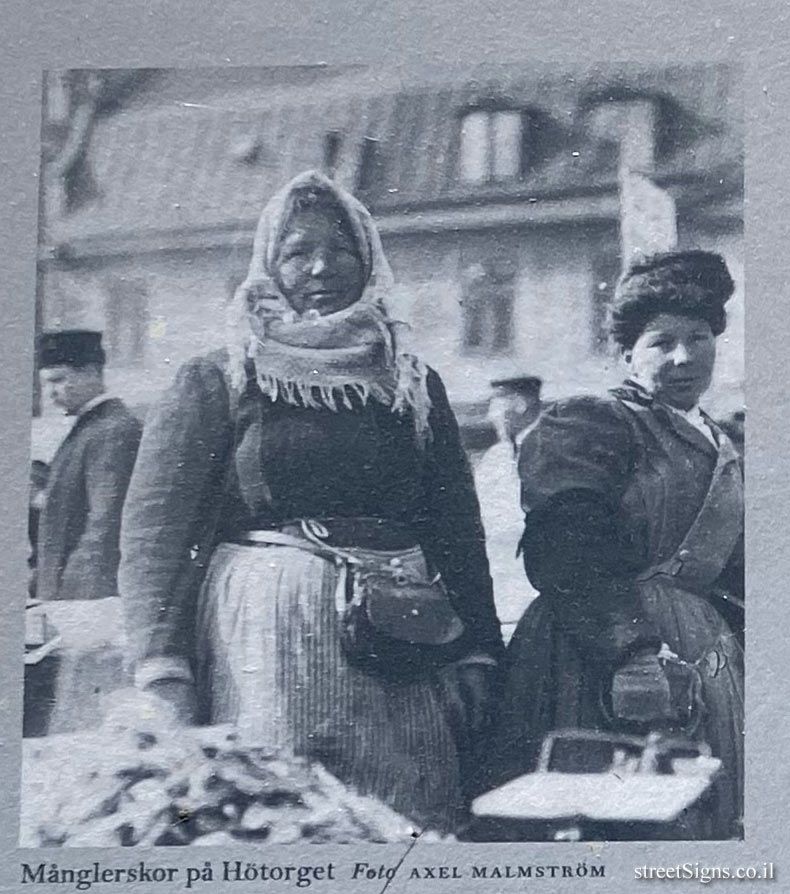One of a series of signs describing streets in the city of Stockholm
The place where the sign is located was photographed on the same day by the same photographer
 Click for a larger image
Click for a larger image The pictures that appear on the sign are shown here enlarged, with the translation of the text below (the pictures are numbered from top to bottom)
(1) Peddler’s shoes on Hötorget - Photo AXEL MALMSTRÖM
 Click for a larger image
Click for a larger image (2) Hötorget in 1953. On the left, the demolition for the subway construction and the five high-rise buildings at Sergelgatan has begun. The new elementary school behind Hötorgshallen is almost completely demolished and soon several buildings will go the same way, the Sculptor’s residence, the house with round-arched windows diagonally left behind Hötorgshallen, once the sculptor Sergel’s studio, the Old Art School, the Technical School until 1945, the house with the lantern on the roof and the old Hötorgshallen in the middle of the picture.
Photographs in the Stockholm City Museum
 Click for a larger image Translation of the text on the sign
Click for a larger image Translation of the text on the sign:
[Translation of the text in Swedish]
Hötorget (Hay Square) IN GUSTAV VASA’S TIME, the New barn was located here where farmers drove hay and straw to the king’s cows and horses. Perhaps the name Hötorget, known from the 1640s, is connected with the habit of unloading hay loads right here.
In 1663, the government decided that horse markets should be held on Hötorget on the first day of each month.
Bondtorget and Mänglartorget In 1856, the hay trade was moved to Norrmalmstorg and Hötorget became Salutorg, twice as large as it is now. On Bondtorget in the north, meat and milk were sold, on Månglartorget in the south, vegetables and bread. Anyone was allowed to trade in the square. There were rules for how to behave, but there was no control of the food. In 1882, a market hall was built on the southern side of Månglartorget. Then part of the food trade could take place under roofs and with better hygiene.
Farm quarters, cattle trade and slaughterhouses At Holländargatan there were livestock trades and slaughterhouses. Around the square there were accommodation places »farmers quarters«, cellars and taverns. On the site of the Concert Hall was Stora Hälsingegården, where farmers from Norrland could get a trough for their horses, a bench to sleep on and a glass after finishing their business. The Hälsinge dogs sold young horses in the autumn. People from the same area had company on the trip and kept iStockholm together.
Some valley folk also stayed at Hötorget. Where the First high-rise building stands, there was a farm where river valleys and play sand men lived and handled firewood, an activity that still existed in the early 1950s.
[б]PUB[/б]
Paul Urbanus Bergström was a young Västgöte who came to Stockholm in 1876. He got a job with a flea market dealer at Hötorget. At the age of 22, he opened his own shop and a tailoring shop. Bergström sold ready-made clothes, which was new. He abolished the bargaining system and introduced fixed prices. By 1889 he had shops in every corner of the square. In 1925, Paul U Bergström’s modern department store PUB was opened, which in 1935 was taken over by the Cooperative Union.
The concert hall The Blue Concert Hall, designed by architect Ivar Tengbom and inaugurated in 1926, is Stockholm’s finest example of neoclassical architecture. Carl Mille’s Orpheusbrunn was built in 1936. The concert hall’s tall columns in gray granite, the enormous gates, the stairs and the well together play a mighty concert.
Kungsgatan 44 The house Kungsgatan 44, designed by architect Edward Bernhard, was completed in 1935 and is a fine example of the early functionalism building style. The two staggered upper floors create the foundation for a multitude of illuminated advertising. The two lower floors are terraced and extended towards Hötorget and were intended to be demolished in the event of a possible widening of Kungsgatan.
City Sanitation During the city renovation in the 1950s and 1960s, almost all buildings south of Hötorget were demolished. Many famous buildings disappeared, as did the narrow, narrow streets with alternating facades.
The new Hötorgscity was inaugurated in April 1959 when the First High-rise, designed by David Helldén, was completed. The four other high-rise buildings and the pedestrian street were completed during the early 1960s.
On terraces one floor up from the geometric pattern of Sergelgatan there were gardens, cafes and restaurants. The high-rises were likened to »five trumpet blasts« and Stockholm had become a modern commercial center.
[images]
(1) Peddler’s shoes on Hötorget Photo AXEL MALMSTRÖM
(2) Hötorget in 1953. On the left, the demolition for the subway construction and the five high-rise buildings at Sergelgatan has begun. The new elementary school behind Hötorgshallen is almost completely demolished and soon several buildings will go the same way, the Sculptor’s residence, the house with round-arched windows diagonally left behind Hötorgshallen, once the sculptor Sergel’s studio, the Old Art School, the Technical School until 1945, the house with the lantern on the roof and the old Hötorgshallen in the middle of the picture.
Photographs in the Stockholm City Museum
The board was put up in 2004 by Stockholm’s street and property office in collaboration with Norrmalm’s stadsdelsforvaltning
www.stockholm.se

 Click for a larger image
Click for a larger image  Click for a larger image
Click for a larger image  Click for a larger image
Click for a larger image